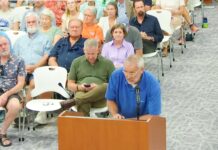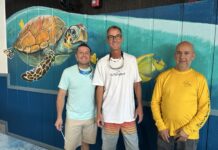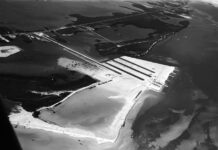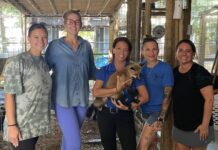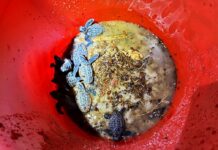Editor’s Note: This is the second in a four-part series on Monroe County’s 200th year.
When the second escalation of the Seminole War erupted in 1835, fear spread throughout South Florida and the Keys. Between 1836 and 1840, both experienced several acts of hostility, including attacks at New River (Fort Lauderdale), Cape Florida Lighthouse (Key Biscayne), Key Largo, Tavernier Key and the southernmost attack in the Florida Keys, the Aug. 7, 1840 event at Indian Key.
With the conclusion of the second escalation in 1842, the Navy depot, established first on Tea Table Key and later moved to Indian Key, was abandoned. At Indian Key, the only evidence of the former military presence is three round red-bricked cisterns. While Indian Key, once the most important island in the Florida Keys not named Key West, had been deserted, Key West was thriving.
As it turned out, the outpost city was not some one-trick pony relying solely on the wrecking industry to bring dollars to Key West. New industries were on the rise. In 1849, a sampling of sponges harvested from local waters was sent to markets in New York to be graded for their quality. They were judged to be just as good as those imported from the Mediterranean, and with that nod of approval, the sponge industry was born.
Did you know that the sponge industry inadvertently spawned what has become the Florida Keys’ very own sweet claim to fame, Key lime pie? It began as a hooker’s tale. Hookers, in this case, were the men manipulating 30-, 40- and 50-foot poles as they scooped up sponges growing on the ocean floor. They did not work alone and were accompanied on their boats by partners who peered beneath the surface through glass-bottom barrels and worked to direct the aim of their partner’s pronged poles.
In 1856, the process for making sweetened condensed milk was patented, and that accomplishment significantly affected local history. For the spongers out on their boats for days at a time, it enabled them to keep a dairy product to sweeten their coffee. At some point, they began to use those cans of sweetened condensed milk to create a treat. After pouring milk into their coffees, they mixed fresh squeezed lime, egg and stale Cuban bread in the can.
When they returned to the mother ship with their haul of sponges, a sweet treat awaited them. Eventually, the combination of ingredients made its way to Key West kitchens, and Key lime pie went on to become Florida’s official state pie.
While the sponge industry was booming, the wrecking industry was being affected by navigational improvements. On Dec. 3, 1855, the following appeared in the Bangor Daily Whig and Courier: “Since the erection of the celebrated Carysfort and Sand Key Iron Lighthouses and the establishment of the Coast Survey of a chain of beacons along the whole extent of the reef, the falling off in the wrecking business has been very great. In 1846 and 1847, over forty vessels were engaged wholly in saving lives and property upon this coast. At the present time, there are but twenty regularly employed and this number will soon be reduced, the business being too uncertain and the salvage decreased where service is rendered too inadequate. Since, then, wreckers are falling and wrecks becoming rare, rates of insurance must be reduced to correspond more equally with the risks incurred.”
Work marking the Florida Reef continued. In 1857, the Lighthouse Board recommended a series of iron lighthouses to mark the reef line so that it would become “as perfectly lighted as it is believed any capable and intelligent mariner could desire. In a distance of three hundred miles there will then be Dry Tortugas, Sand Key, Dry Bank (Sombrero Reef), Alligator Reef, Carysfort Reef, Cape Florida and Sebastian Inlet seacoast lights.”
Some lighthouses were finished before others, thanks in no small part to delays caused by the Civil War. Eventually, six lighthouses were established at the reef. In addition to the Carysfort Reef and Sand Key lighthouses, Sombrero Key Lighthouse was lit in 1858, Alligator Reef Lighthouse in 1873, Fowey Rocks Lighthouse in 1878, and American Shoal Lighthouse in 1880.
By the turn of the century, the wrecking industry was gasping its last breaths. Back on land, however, new industries had blossomed. Because wrecking was not a full-time job, many wreckers developed side jobs like fishing, turtling and, for Captain Ben Baker, pineapple farming. Baker, once referred to as the King of the Florida Wreckers, is considered the first to introduce pineapple farming to the Florida Keys. He was not the last.
In the latter half of the 19th century, farming became a flourishing industry in the Florida Keys, especially in the Middle and Upper Keys, and the pineapple was a primary cash crop. In 1870, Baker was said to have made $7,000 from his crop of pineapples. In 2023 dollars, that tidy sum would be more than $162,000, which is not too shabby for a side gig.
In addition to sponges and pineapples, cigars were affecting the local economy.
It was 1831 when William H. Wall established his small cigar factory employing about 50 people in Key West. By 1884, 80 cigar factories, filled chiefly with Cubans who fled their home because of political unrest, were hand-rolling cigars with Cuban tobacco on the island. At the height of the cigar industry, 200 Key West factories were hand-rolling 100 million cigars annually.
Like wrecking, sponging and pineapples, the cigar industry boomed and busted after factories, including that of Vincente Martinez Ybor, moved their production to Tampa. Ybor City went on to become recognized worldwide for its cigars.
For Key West and a few scores of the other islands in the chain, Henry Flagler’s plans were about to change the island chain forever.



